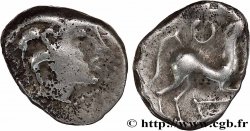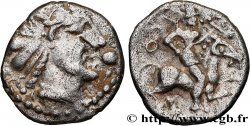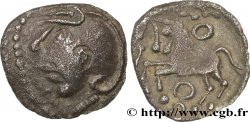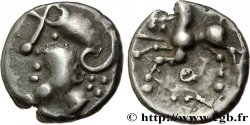bga_175478 - GALLIA - ÆDUI (BIBRACTE, Area of the Mont-Beuvray) Denier à la tête casquée, fourré
недоступный.
Товар уже продан в нашем интернет-магазине (2010)
Цена: : 25.00 €
Товар уже продан в нашем интернет-магазине (2010)
Цена: : 25.00 €
Тип Denier à la tête casquée, fourré
Дата: c. 80-50 AC.
Монетный двор / Город: Autun (71)
Металл: silver
Диаметр: 12,5 mm
Ориентация осей монеты: 9 h.
Вес: 1,09 g.
Комментарии о состоянии
Flan court, mais frappe relativement centrée des deux côtés. La pellicule d’argent manque complètement sur la joue et devant le nez au droit et sur le corps du cheval au revers
Ссылки в каталоге: :
Лицевая сторона
Аверс: легенда: ANÉPIGRAPHE.
Аверс: описание: Tête casquée à gauche ; derrière, croix formée de quatre globules ; grènetis.
Обратная сторона
Реверс: легенда: ANÉPIGRAPHE.
Реверс: Описание: Cheval libre galopant à gauche ; un annelet pointé au-dessus et un autre entre les jambes ; un timon devant.
Комментарий
Pour le revers, il existe de nombreuses combinaisons, selon qu'il y a une rouelle, un annelet ou un annelet pointé de part et d'autre du cheval. Le classement du Nouvel Atlas distingue deux classes, selon que la base du cou est décorée (classe I) ou que l’effigie est stylisée (classe II). La troisième classe est à ignorer ; le critère du torque sous l’annelet entre les jambes du cheval peut être systématique, mais il est quasi systématiquement hors flan... il est en bord de flan sur la monnaie DT. 3189 pourtant de la classe II !.








 Cообщить об ошибке
Cообщить об ошибке Распечатать страницу
Распечатать страницу Отправить мой выбор
Отправить мой выбор Задать вопрос
Задать вопрос Consign / sell
Consign / sell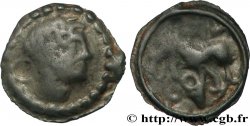
 Информация
Информация